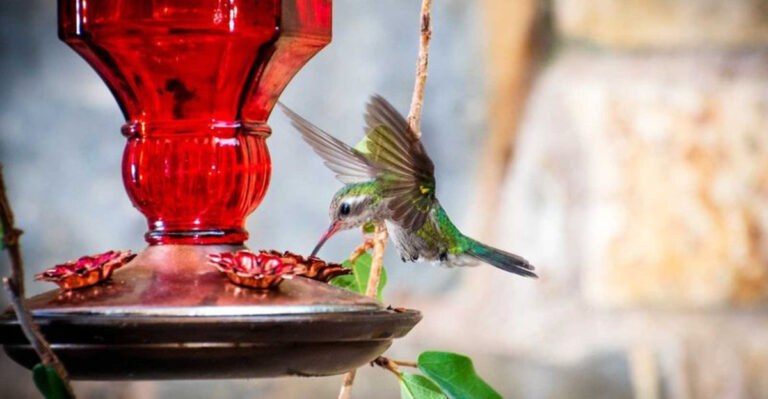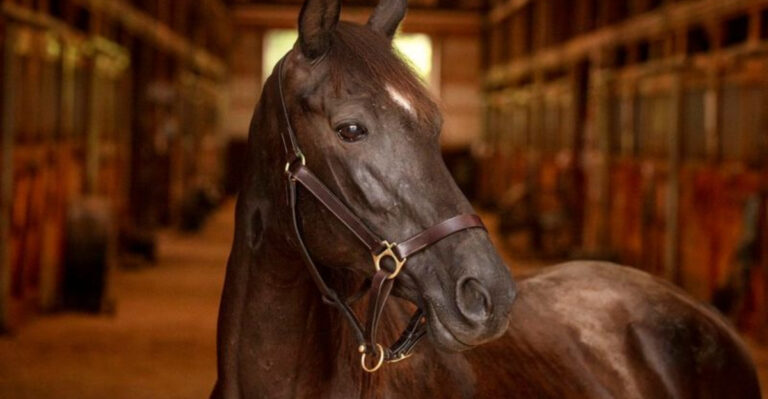What Do Deer Eat? These 29 Foods Are Their Absolute Favorites

Ever spotted a deer munching away in your backyard or a forest clearing? These graceful creatures have quite the appetite and a diverse palate that changes with the seasons.
Understanding what deer love to eat not only satisfies curiosity but also helps gardeners protect their plants and wildlife enthusiasts better appreciate these magnificent animals in their natural habitat.
1. Acorns
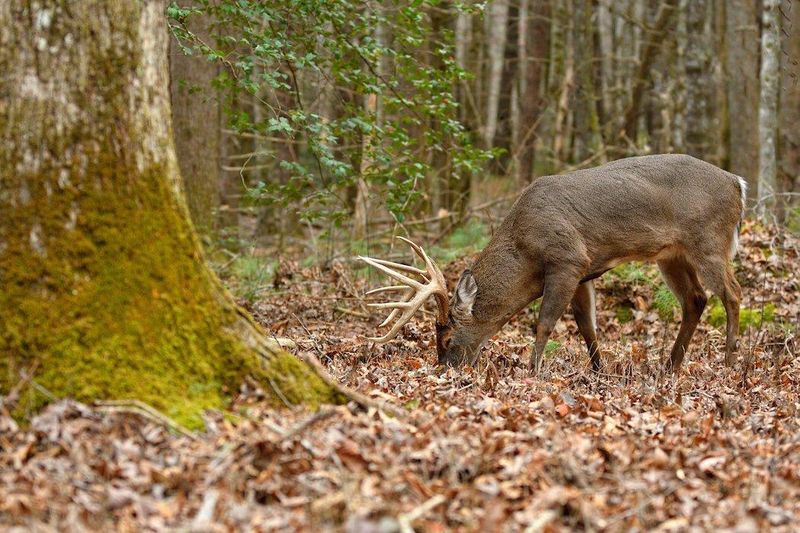
Fall brings a bonanza of these nutty treats that deer can’t resist. Acorns are packed with fats and carbohydrates that help deer build up crucial fat reserves for winter survival.
White oak acorns are preferred over red oak varieties because they contain less tannin and taste less bitter. A single deer can consume several pounds of acorns daily during autumn abundance!
2. Apple Drops

Nothing attracts deer quite like the sweet aroma of fallen apples. These fruity delights offer natural sugars and moisture, making them irresistible treats during late summer and fall.
Wild apple trees in abandoned orchards become deer magnets. The animals often wait patiently for apples to drop naturally, though they’ll occasionally stand on hind legs to reach low-hanging fruit from branches.
3. Corn

Golden kernels rank among the ultimate deer delicacies. Agricultural fields often experience nighttime visits from deer herds seeking this calorie-rich food source.
Corn provides exceptional energy through its high carbohydrate content. Many wildlife managers and hunters use corn in feeders to attract deer, though this practice is regulated differently across states to prevent disease spread and ethical concerns.
4. Soybeans
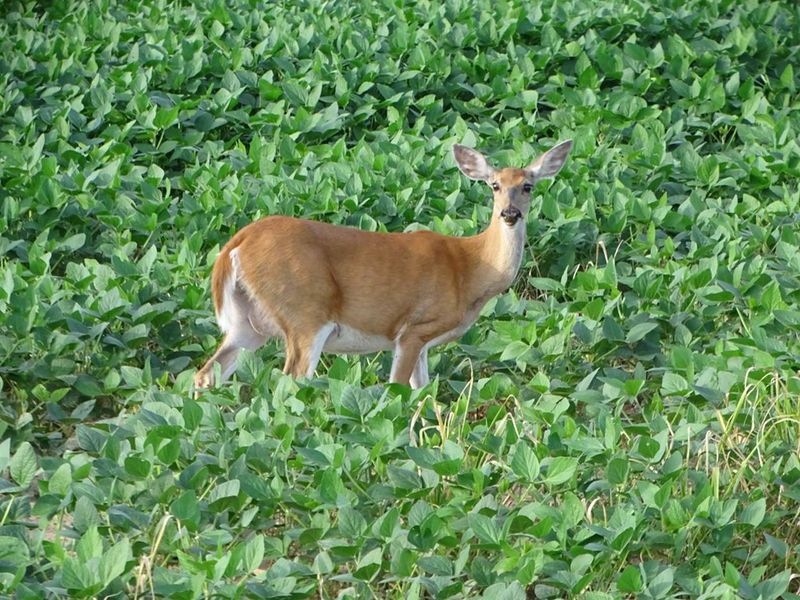
Farmers often find these protein-packed legumes disappearing from field edges overnight. Soybeans offer deer crucial protein content, especially beneficial for antler growth in bucks and milk production in nursing does.
Young soybean plants with tender leaves are particularly attractive during spring. Later in the season, deer return to feast on the mature bean pods, creating a year-round attraction in agricultural areas.
5. Oak Leaves
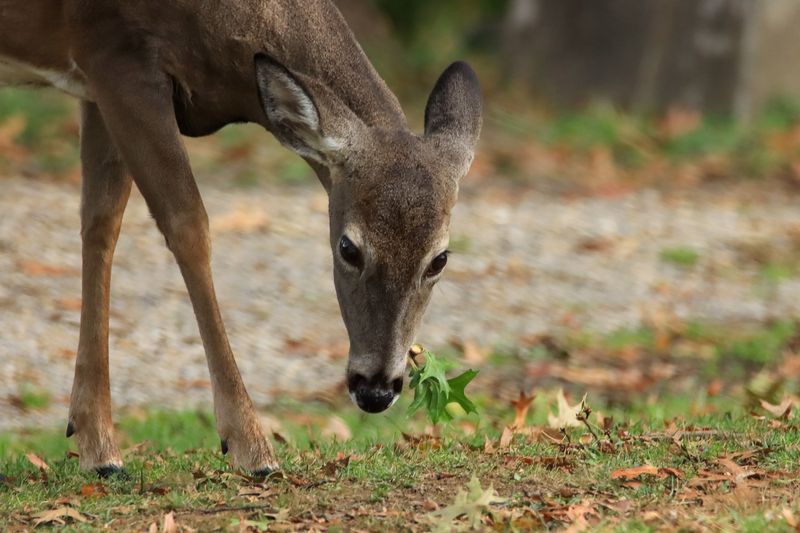
Fresh spring oak leaves provide tender, nutritious forage when deer need it most. After winter’s scarcity, these protein-rich leaves help replenish depleted body reserves.
Oak leaves contain varying tannin levels depending on species and season. Deer typically prefer white oak varieties over red oak because of lower tannin content. As leaves mature and toughen throughout summer, deer gradually shift their attention to other food sources.
6. Clover
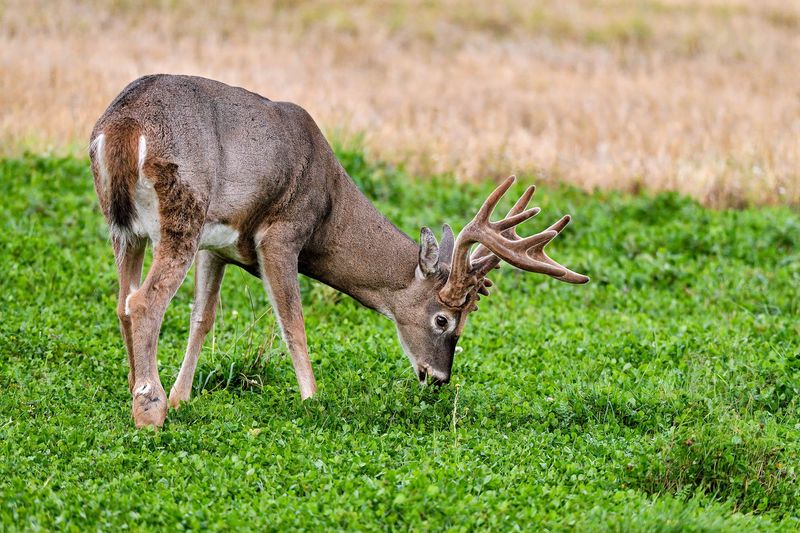
Lush clover patches attract deer like magnets to a refrigerator. This legume provides exceptional protein content and digestibility, making it a nutritional powerhouse for growing fawns and nursing does.
Food plotters often plant clover specifically to attract deer. The plant’s rapid regrowth after grazing makes it sustainable even with heavy browsing pressure. Morning dew on clover fields creates perfect conditions for observing deer during their active feeding times.
7. Blackberry Brambles
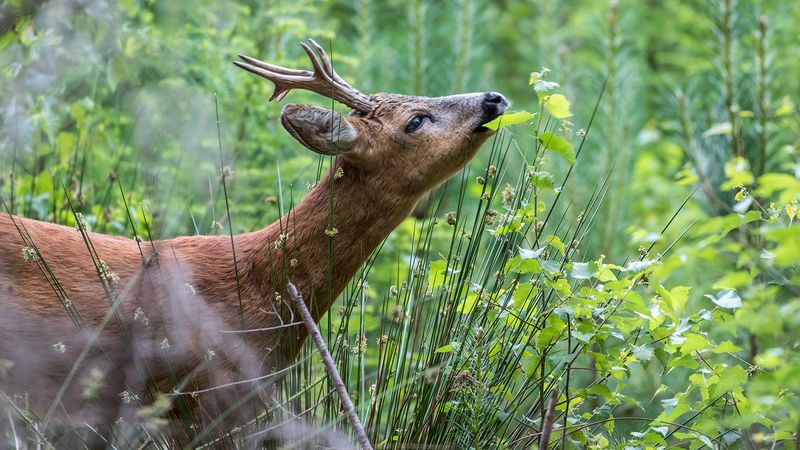
Summer brings sweet rewards as deer navigate thorny patches to reach juicy blackberries. Beyond the fruits, deer also consume the nutritious leaves and tender shoots of blackberry plants year-round.
These brambles offer more than just food. Dense thickets provide excellent protective cover for resting and fawning areas. Young growth after forest fires or clearing operations becomes prime deer browsing habitat with its abundance of tender shoots.
8. Mushrooms
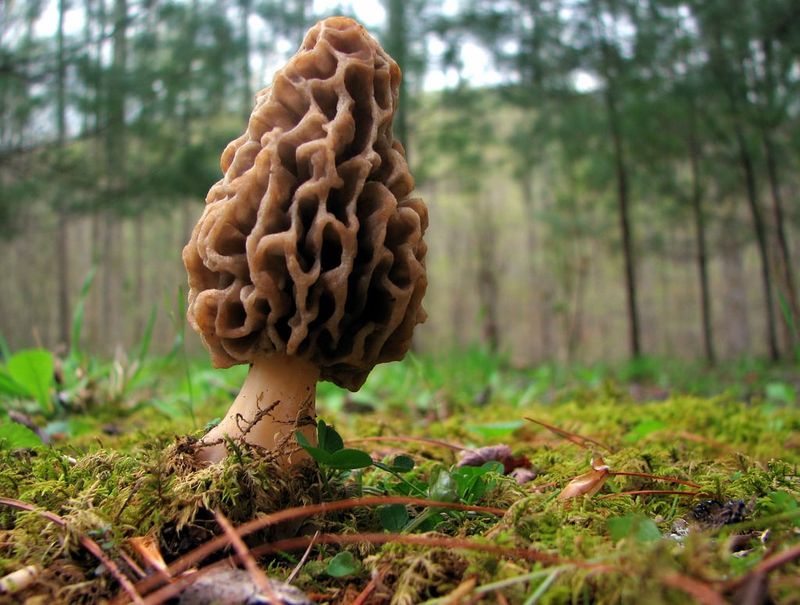
Rainy days bring forth fungal treasures that deer discover with their keen sense of smell. Forest-dwelling deer develop quite the appetite for various mushroom species, especially during humid summer months.
Unlike humans who must carefully identify safe varieties, deer seem to instinctively recognize non-toxic mushrooms. These fungi provide minerals and nutrients otherwise scarce in their woody environment. Deer have been observed digging to unearth certain underground mushroom species.
9. Hostas
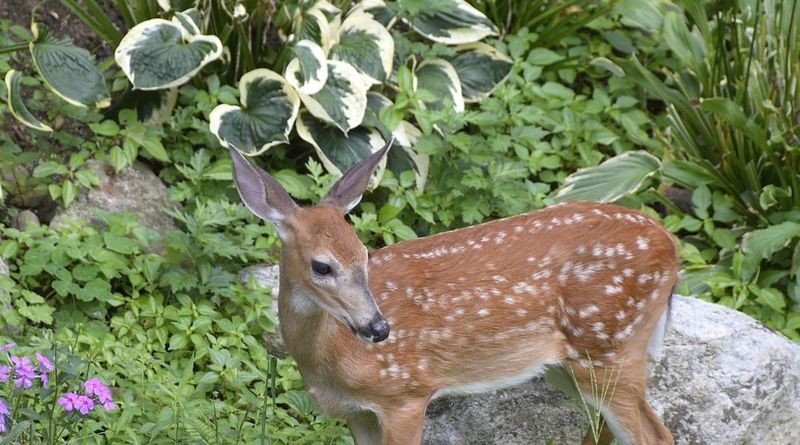
Gardeners know the heartbreak of finding prized hostas reduced to stems overnight. These ornamental plants might as well be labeled “deer candy” in suburban landscapes.
The broad, tender leaves offer moisture and nutrients with minimal effort. Despite numerous “deer-resistant” varieties on the market, hungry deer will devour most hostas when natural food is scarce. Morning garden visits often reveal the telltale jagged edges of deer browsing.
10. Cedar Branches
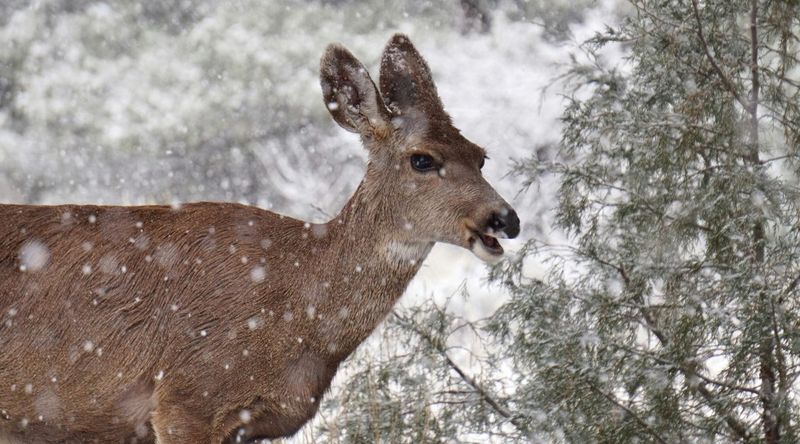
Winter’s harsh conditions drive deer to browse on evergreen sustenance. Cedar branches provide accessible nutrition when snow covers other food sources.
Though not their first choice, these aromatic boughs become increasingly important during deep winter. Young deer often stand on hind legs or push branches down with their weight to reach higher foliage. Heavy browsing creates a distinct “browse line” visible on cedar trees in areas with high deer populations.
11. Peanut Butter
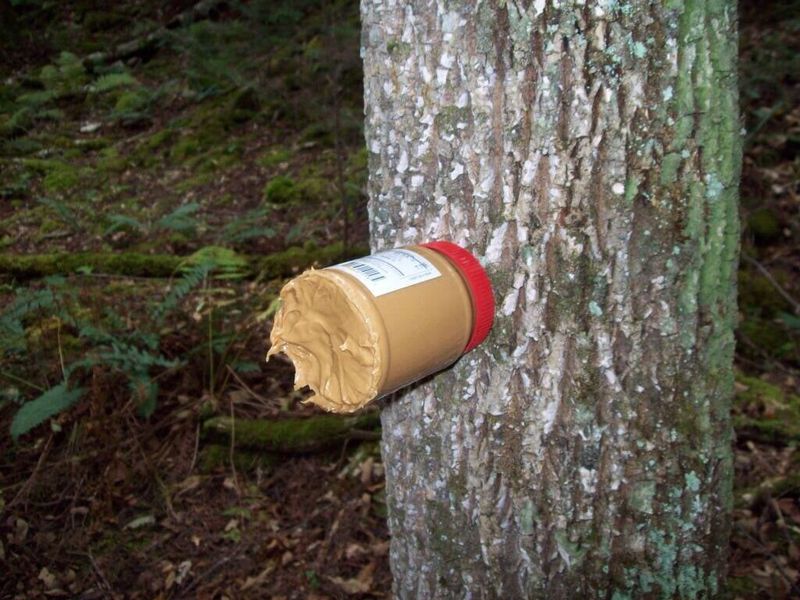
Wildlife enthusiasts discovered this unconventional deer attractant years ago. The rich aroma and high calorie content make peanut butter irresistible to curious deer.
Though not part of their natural diet, deer quickly develop a taste for this treat. Wildlife photographers and observers often smear small amounts on tree trunks to attract deer for viewing. The protein and fat content provides beneficial nutrition during energy-demanding winter months.
12. Rose Bushes

Gardeners often discover their prized roses transformed into thorny sticks overnight. Deer consider both the tender new growth and mature blooms as delectable treats.
Despite the thorns, determined deer will consume entire rose plants if hungry enough. The nutritional value and moisture content make these ornamentals worth the effort for browsing deer. Even “deer-resistant” varieties often fall victim when natural food sources become scarce.
13. Persimmons
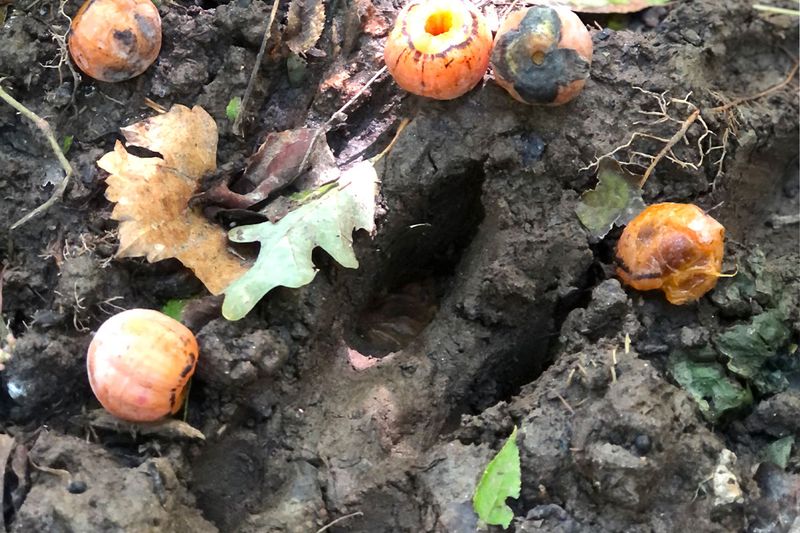
Autumn brings sweet orange treasures that deer track down with remarkable precision. Wild persimmons create feeding hotspots in forests as their fruits ripen and fall.
The sugar-rich pulp provides excellent energy for deer preparing for winter. Hunters often scout persimmon trees as prime ambush locations during hunting season. Deer will return repeatedly to these trees, even pawing through leaves to find fallen fruits.
14. Alfalfa
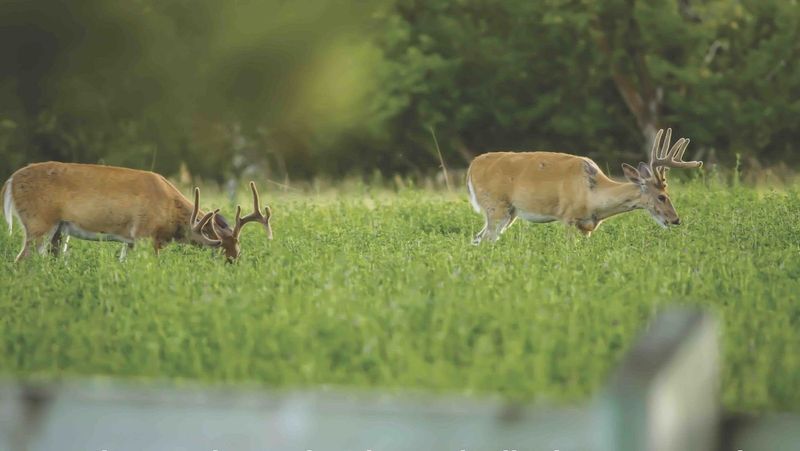
Farmers know all too well how quickly deer discover alfalfa fields. This premium forage provides exceptional protein content and digestibility, making it nutritional gold for deer.
Pregnant and nursing does particularly benefit from alfalfa’s nutritional profile. The plant remains attractive through multiple growth stages, from tender shoots to mature hay. Wildlife managers sometimes plant alfalfa specifically to draw deer away from agricultural crops.
15. Pumpkins
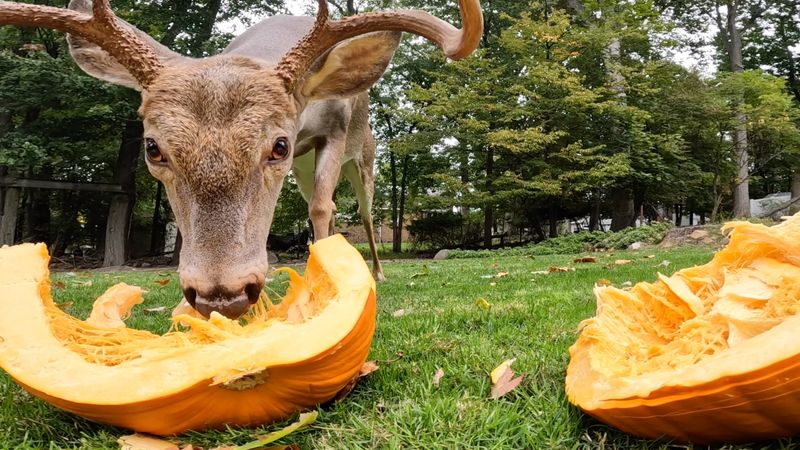
Post-Halloween decorations become unexpected deer buffets in November. Discarded jack-o’-lanterns quickly attract nighttime visitors to suburban yards.
Deer relish both the sweet flesh and nutritious seeds of pumpkins. The high moisture content provides valuable hydration during autumn’s transition to winter. Some wildlife enthusiasts intentionally leave pumpkins out as supplemental deer food after the holiday season ends.
16. Maple Seedlings

Spring forests witness deer methodically browsing tender maple saplings. These young trees offer nutritious, easily digestible growth that deer target specifically.
The selective browsing can significantly impact forest regeneration in areas with high deer populations. Foresters sometimes use protective tubes around valuable saplings to prevent complete consumption. The sweet sap content makes maple species particularly attractive compared to other hardwood seedlings.
17. Tulips

Spring’s colorful garden displays often disappear overnight when deer discover them. These bulb flowers rank among the most frequently consumed ornamentals in suburban landscapes.
The tender stems and bright blooms seem particularly irresistible to deer. Many gardeners have abandoned tulip planting altogether in high-deer areas. Those who persist often resort to protective netting or repellent sprays during the blooming season.
18. Wheat
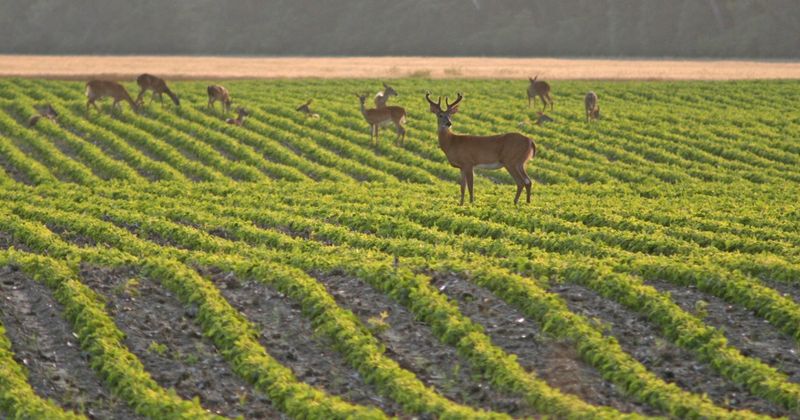
Agricultural fields transform into deer dining halls when wheat reaches its tender growth stage. The protein-rich young shoots provide excellent nutrition during critical spring months.
Farmers often observe deer trails leading from forest edges directly to wheat fields. Later in the season, mature wheat heads also attract feeding deer. Wildlife biologists study these patterns to understand deer movement and habitat use across agricultural landscapes.
19. Crabapples
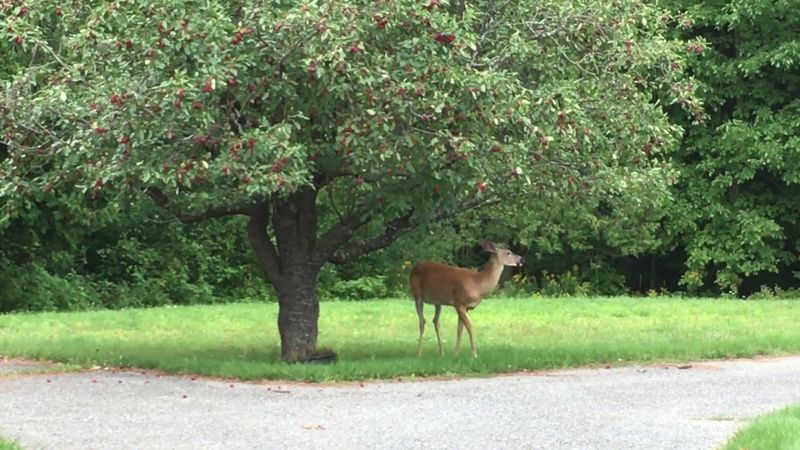
Forgotten ornamental trees become wildlife magnets when their fruits ripen. Crabapples provide concentrated energy sources that deer actively seek out during fall and winter.
Even bitter varieties become palatable after frost softens and sweetens the fruits. Deer will stand on hind legs or wait patiently for windfalls to access this food source. The trees often show heavy browsing pressure on lower branches within deer reach.
20. Sunflower Heads
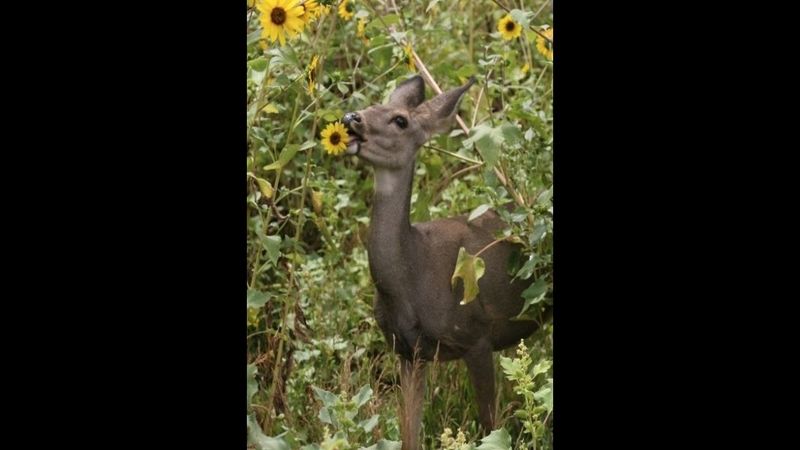
Late summer brings towering yellow flowers that eventually become deer targets. Once the blooms mature and seeds develop, deer begin visiting sunflower patches regularly.
The oil-rich seeds provide excellent energy for pre-winter weight gain. Deer typically wait until heads begin drooping before accessing this food source. Wildlife food plotters often include sunflowers specifically to attract and nourish deer populations.
21. Poison Ivy
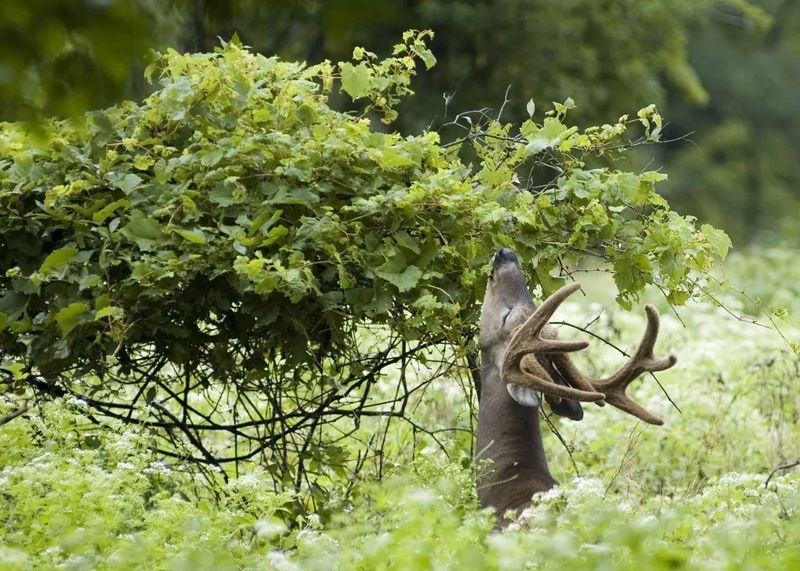
Surprisingly, deer munch this dreaded plant without any ill effects. While humans break out in itchy rashes, deer possess specialized digestive systems that neutralize the urushiol oil.
This consumption actually helps control poison ivy spread in some areas. Deer preferentially browse young, tender poison ivy growth during spring and summer months. Wildlife biologists have documented this feeding behavior as part of understanding deer’s ecological impact.
22. Grape Vines
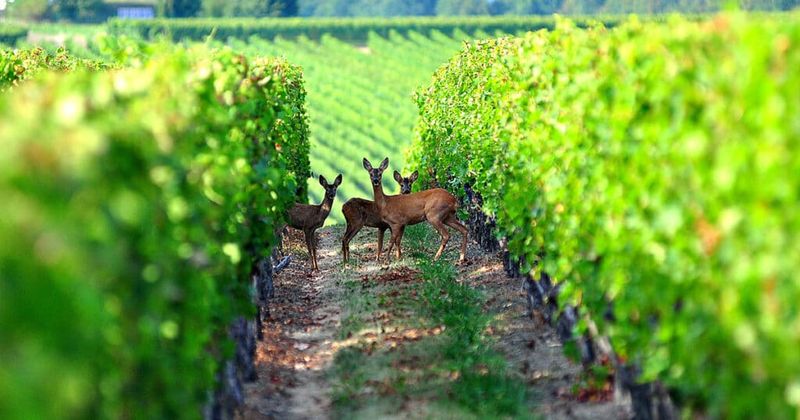
Wild grape tangles provide both food and shelter in forest ecosystems. Deer consume the tender leaves, new shoots, and eventually the ripened fruits of these climbing vines.
The high moisture content makes grape foliage particularly attractive during dry periods. Vineyard owners often struggle with deer damage to commercial operations. The persistent browsing creates distinct “browse lines” on accessible vines in deer-heavy areas.
23. Pine Needles

Winter’s harsh conditions sometimes force deer to consume this less-preferred forage. When deep snow covers preferred foods, pine needles provide accessible, if not ideal, nutrition.
The needles contain some vitamin C and other nutrients that help sustain deer through winter scarcity. Younger, softer needles are preferred over mature, tougher growth. Heavy browsing pressure on pines indicates significant food stress in local deer populations.
24. Bird Seed

Backyard feeders intended for winged visitors often attract four-legged guests instead. Spilled seed creates an easy meal opportunity that deer quickly discover and exploit.
The concentrated nutrition makes bird seed worth investigating for hungry deer. Many homeowners are surprised to find deer visiting at dawn or dusk to clean up beneath feeders. This unexpected food source becomes particularly important during harsh winter conditions.
25. Raspberry Canes
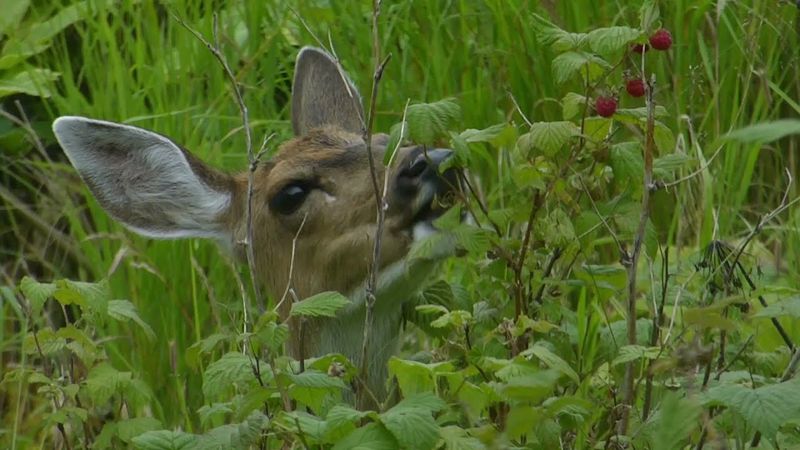
Summer berry patches attract deer for both fruit and foliage. Beyond the obvious sweet berries, deer also browse the nutritious leaves and tender new growth of raspberry plants.
The browsing actually stimulates more vigorous growth in established patches. Homeowners with raspberry gardens often find distinct browse lines where deer have systematically removed foliage within reach. The plants’ thorns provide little deterrent to determined deer.
26. Sumac Berries

Winter’s red clusters provide crucial nutrition when other foods disappear. Staghorn sumac’s distinctive fuzzy berry cones remain accessible above snowfall, creating reliable deer feeding stations.
The tart berries contain beneficial acids and nutrients that help deer through winter’s challenges. Deer paths often lead directly to sumac stands during snowy periods. Wildlife managers recognize these plants as important components of winter deer habitat.
27. Garden Vegetables

Midnight raids transform carefully tended vegetable gardens into deer salad bars. Tender lettuce, peas, beans, and carrots top the list of garden favorites for browsing deer.
The concentrated nutrition and moisture content make vegetables irresistible compared to natural forage. Frustrated gardeners often resort to physical barriers like fencing to protect their harvests. The sweet corn ripening phase creates particularly strong attraction for opportunistic deer.
28. Chestnuts
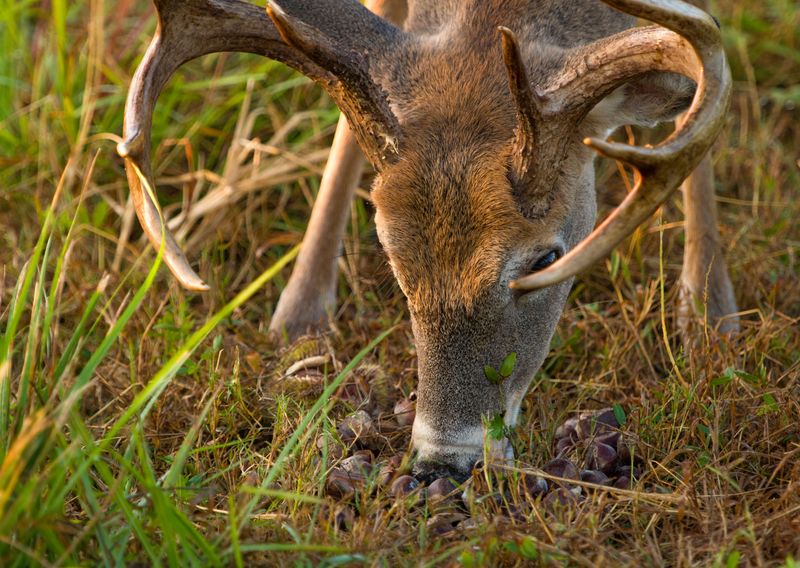
Autumn forest floors become treasure hunts as deer search for these nutritional powerhouses. Before chestnut blight devastated American forests, these nuts formed a dietary cornerstone for eastern deer populations.
Today, remaining Chinese chestnut trees and restoration efforts create feeding hotspots. The nuts provide exceptional fat and carbohydrate content for pre-winter weight gain. Deer will paw through fallen leaves to uncover these prized food items.
29. Grass Hay
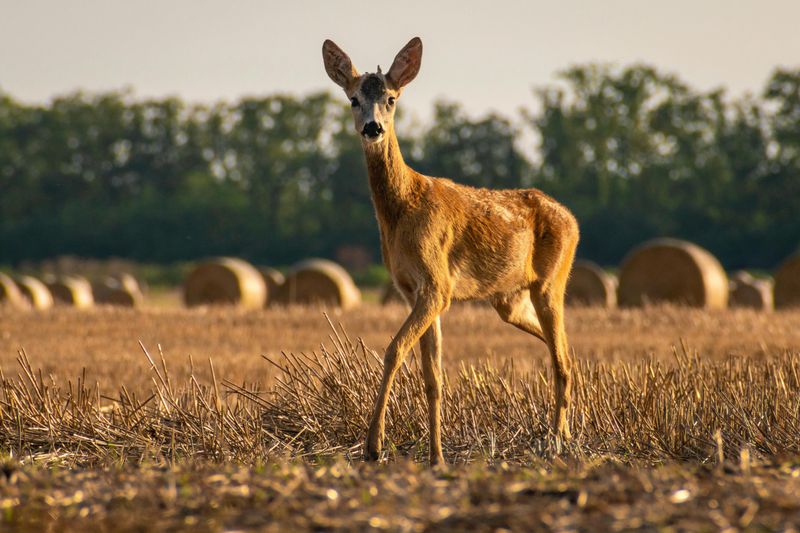
Winter feeding operations often include this supplemental offering for hungry deer. Though not as nutritionally complete as natural browse, hay provides crucial roughage during scarce periods.
Wildlife managers carefully consider timing and placement of hay to prevent disease transmission at crowded feeding sites. In agricultural areas, deer frequently raid stored hay bales during harsh winters. This emergency food source helps sustain deer through extreme weather events.

